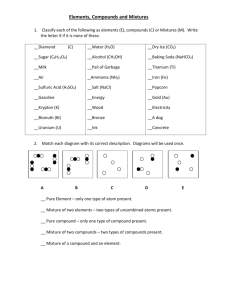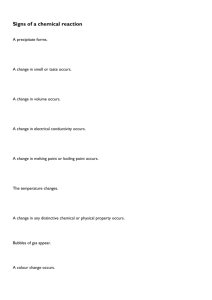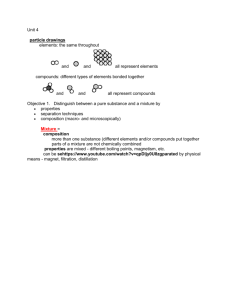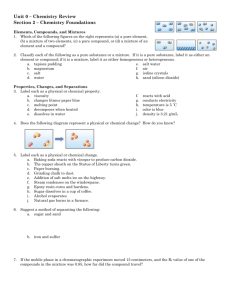Recording Measurements
advertisement
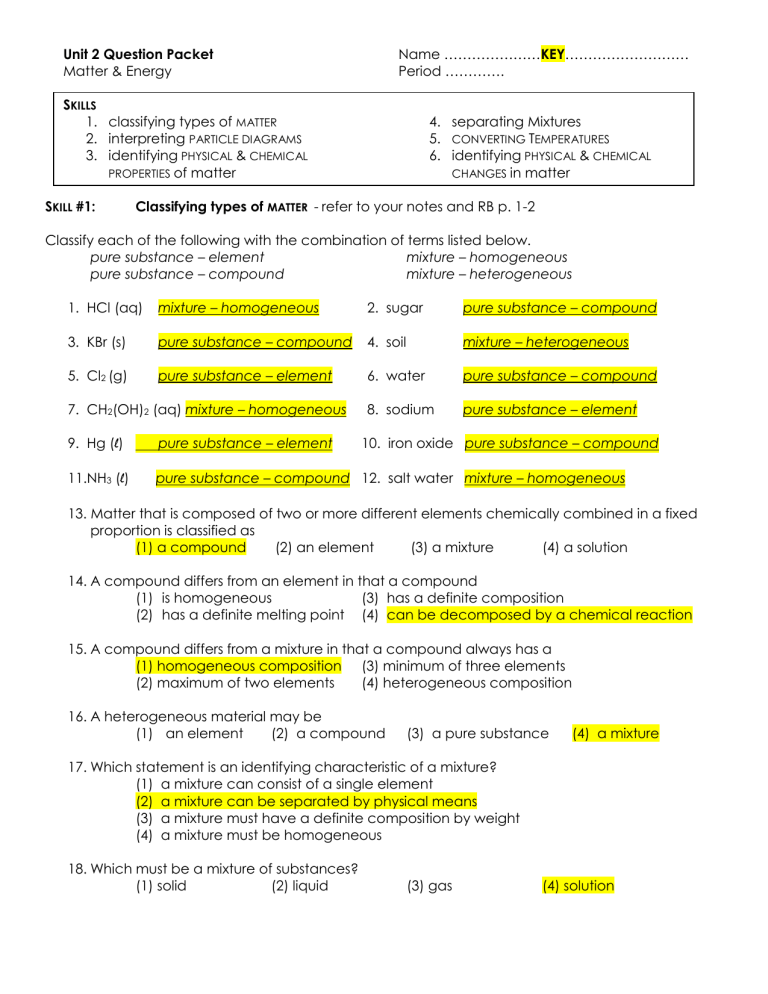
Unit 2 Question Packet Matter & Energy Name …………………KEY……………………… Period …………. SKILLS 1. classifying types of MATTER 2. interpreting PARTICLE DIAGRAMS 3. identifying PHYSICAL & CHEMICAL PROPERTIES of matter SKILL #1: 4. separating Mixtures 5. CONVERTING TEMPERATURES 6. identifying PHYSICAL & CHEMICAL CHANGES in matter Classifying types of MATTER - refer to your notes and RB p. 1-2 Classify each of the following with the combination of terms listed below. pure substance – element mixture – homogeneous pure substance – compound mixture – heterogeneous 1. HCl (aq) mixture – homogeneous 2. sugar pure substance – compound 3. KBr (s) pure substance – compound 4. soil mixture – heterogeneous 5. Cl2 (g) pure substance – element 6. water pure substance – compound 8. sodium pure substance – element 7. CH2(OH)2 (aq) mixture – homogeneous 9. Hg (l) pure substance – element 10. iron oxide pure substance – compound 11.NH3 (l) pure substance – compound 12. salt water mixture – homogeneous 13. Matter that is composed of two or more different elements chemically combined in a fixed proportion is classified as (1) a compound (2) an element (3) a mixture (4) a solution 14. A compound differs from an element in that a compound (1) is homogeneous (3) has a definite composition (2) has a definite melting point (4) can be decomposed by a chemical reaction 15. A compound differs from a mixture in that a compound always has a (1) homogeneous composition (3) minimum of three elements (2) maximum of two elements (4) heterogeneous composition 16. A heterogeneous material may be (1) an element (2) a compound (3) a pure substance (4) a mixture 17. Which statement is an identifying characteristic of a mixture? (1) a mixture can consist of a single element (2) a mixture can be separated by physical means (3) a mixture must have a definite composition by weight (4) a mixture must be homogeneous 18. Which must be a mixture of substances? (1) solid (2) liquid (3) gas (4) solution 19. Which substance can be decomposed by chemical means? (1) aluminum (2) octane (3) silicon (4) xenon 20. Which substance can be decomposed by chemical means? (1) ammonia (2) oxygen (3) phosphorus (4) silicon 21. Which substance can not be broken down by a chemical reaction? (1) ammonia (2) argon (3) methane (4) water 22. Two substances, A and Z, are to be identified. Substance A can not be broken down by a chemical change. Substance Z can be broken down by a chemical change. What can be concluded about these substances? (1) Both substances are elements. (2) Both substances are compounds. (3) Substance A is an element and substance Z is a compound. (4) Substance A is a compound and substance Z is an element. 23. Tetrachloromethane, CCl4, is classified as a (1) compound because the atoms of the elements are combined in a fixed proportion (2) compound because the atoms of the elements are combined in a proportion that varies (3) mixture because the atoms of the elements are combined in a fixed proportion (4) mixture because the atoms of the elements are combined in a proportion that varies 24. Two different samples decompose when heated. Only one of the samples is soluble in water. Based on this information, these two samples are (1) both the same element (3) both the same compound (2) two different elements (4) two different compounds 25. The table below shows the mass and volume data for four samples of substances at the same temperature and pressure. Which two samples could consist of the same substance? ______ and ______ A and C 26. Which terms are used to identify pure substances? (1) an element and a mixture (2) an element and a compound (3) a solution and a mixture (4) a solution and a compound SKILL #2: Interpreting PARTICLE DIAGRAMS - refer to your notes and RB p. 1-3 27. The following diagram represents a mixture of substances. Each circle represents a different type of particle or atom. Classify the components of the mixture as monatomic elements, diatomic elements, or compounds. a. monatomic element d. b. diatomic element e. c. diatomic element compound compound 28. Look at the following particle diagrams. Identify each as a pure substance or a mixture. Then identify its composition as elements only, compounds only, or elements and compounds. a. b. Pure Substance or Elements Compounds only only c. Pure Substance or Elements only Compounds only Mixture Elements and Compounds Pure Substance Elements only or Compounds only Mixture Elements and Compounds d. Mixture Elements and Compounds Pure Substance Elements only or Compounds only Mixture Elements and Compounds 29. Match each description, a through d, with the appropriate diagram. Then identify if it represents an element, compound, or both. a. N2 b. CH4 c. mixture of gases d. H2O ____d element compound both _____c element compound both _____b element compound both _____a element compound both 30. The particle diagrams below represent substances at standard temperature and pressure (STP). Place the symbols s, l, and/or g next to the properties which apply in the table below. Note: two of the properties will have two answers. Solid (s) Definite shape Definite volume Particles in a fixed/rigid geometric pattern Most dense SKILL #3: Gas (g) Liquid (l) s s,l s S Takes the shape of its container l, g Compressable g Expands to fill its container g Least dense g Identifying PHYSICAL & CHEMICAL PROPERTIES of matter - refer to your notes and RB p. 13 31. Identify the following as either a physical property (P) or a chemical property (C). (Hint: there are only 5 chemical properties listed below, the rest are physical properties.) a. _____P Magnesium is malleable. b. _____P Magnesium conducts electricity. c. _____C Magnesium reacts with an acid. d. _____P Magnesium has a high boiling point. e. _____C Iron reacts with oxygen to form rust. f. ____C Iron forms a compound with chlorine. g. _____P Salt dissolves in water. h. _____C Hydrogen gas burns in air. i. _____P Sodium chloride forms an aqueous solution. j. ____P Hydrogen gas has a density of 0.00009 g/cm3 at STP. k. _____P Hydrogen gas has a boiling point of -253ºC at standard pressure. l. _____C Oxygen can combine with a metal to produce a compound. m. ____P Oxygen gas is slightly soluble in water. n. _____P Oxygen gas can be compressed. o. _____P Compound A is a blue color. p. _____P Water freezes at 0ºC. q. _____P Gold can be flattened into sheets. r. _____P Iron conducts electricity and heat. s. t. _____P Oxygen gas is colorless. _____P Copper can be drawn into a wire. 32. A large sample of a solid is crushed into smaller pieces for testing. Which two physical properties are the same for both the large sample and one of the smaller pieces? (1) mass and density (3) solubility and density (2) mass and volume (4) solubility and volume 33. Describe one appropriate laboratory test that can be used to determine the malleability of a solid sample of an element at room temperature. [1] Place the sample on a solid surface. Strike the sample with a hammer several times to see if the sample flattens. Try to bend the sample to change the shape. 34. Copper is used in home wiring and electric motors because it has good electrical conductivity. Other uses of copper not related to its electrical conductivity include coins, plumbing, roofing, and cooking pans. Aluminum is also used for cooking pans. At room temperature, the electrical conductivity of a copper wire is 1.6 times greater than an aluminum wire. The heat conductivity of copper is 1.8 times greater than the heat conductivity of aluminum. The density of copper is 3.3 times greater than the density of aluminum. a. Identify one physical property of copper that makes it a good choice for uses that are not related to electrical conductivity. [1] Copper is very malleable OR good conductor of heat OR high melting point b. Identify one physical property of aluminum that could make it a better choice than copper for a cooking pan. [1] An aluminum pan has less mass than a copper pan of the same size because aluminum is less dense OR Aluminum is less dense than copper OR A Cu pan would weigh more. SKILL #4: Separating MIXTURES – refer to your notes and RB p. 2 35. When a mixture of water, sand, and salt is filtered, what passes through the filter paper? (1) water, only (2) water and sand (3) water and salt (4) water, sand, and salt 36. Recovering the salt from a mixture of salt and water could best be accomplished by (1) evaporation (2) filtration (3) paper chromatography (4) density determination 37. Which mixture can be separated by using the equipment shown below? (1) NaCl(aq) and SiO2(s) (2) NaCl(aq) and C6H12O6(aq) (3) CO2(aq) and NaCl(aq) (4) CO2(aq) and C6H12O6(aq) SKILL #5: CONVERTING TEMPERATURES – refer to your notes and RB p. 5 38. Which is not a form of energy? (1) light (2) temperature (3) electricity (4) heat 39. A student records the temperature of a substance as it is heated using both the Celsius and Kelvin scales. She records the temperatures over time as shown in the table below. Temperature Time (min) Description ºC K 0 0 273 ice melts/water freezes 5 20 293 room temperature 10 37 310 body temperature 25 100 373 water boils/steam condenses 35 163 436 oven baking temperature a. On the graph, mark appropriate scales on the axes. [1] b. Plot the data from the data table. Plot Celsius temperatures using the symbol . Plot Kelvin temperatures using the symbol . Circle and connect the points, keeping the two lines separate. [1] Relationship between c. What does the graph reveal about the the Kelvin & Celsius Scales relationship between the Celsius and Kelvin scales? The Kelvin scale is always 273 degrees higher than the Celsius scale. If the temperature changes a certain amount on the Cesius scale, it changes the same amount on the Kelvin scale. Temperature (ºC and K) Time (min) 40. Convert the following Celsius temperatures into Kelvins – use the equation on Table T and SHOW YOUR WORK: K = ºC + 273 a. 5 °C + 273 = 278 K h. 400 °C + 273 = 673 K b. 78 °C + 273 = 351 K i. –10 °C + 273 = 263 K c. 100 °C + 273 = 373 K j. –157 °C + 273 = 116 K d. 250 °C + 273 = 523 K k. –273 °C + 273 = 0 K (Absolute Zero!) e. 273 °C + 273 = 546 K l. f. m. 25 °C + 273 = 298 –55 °C + 273 = 218 K g. 373 °C + 273 = 646 K 37 °C + 273 = 310 K 41. Convert the following Kelvin temperatures into degrees Celsius – use the equation on Table T and SHOW YOUR WORK: K = ºC + 273 a. 5 K – 273 = –268 ºC h. 400 K – 273 = 127 ºC b. 78 K – 273 = –195 ºC i. 10 K – 273 = –263 ºC c. 100 K – 273 = –173 ºC j. 157 K – 273 = –116 ºC d. 250 K – 273 = –23 ºC k. 200 K – 273 = –73 ºC e. 273 K – 273 = 0 ºC l. f. m. 25 K – 273 = –248 ºC 550 K – 273 = 277 ºC 37 K – 273 = –236 ºC g. 373 K – 273 = 100 ºC 42. Is it possible to have a negative Kelvin temperature? Explain. No, it is not possible to have a negative Kelvin temperature because 0 Kelvin is the lowest possible temperature (absolute zero). 43. The temperature of an object changes by 100ºC. The same temperature change in Kelvins would be (1) 100K (2) 173 K (3) 272 K (4) 373 K 44. The difference between the boiling point and the freezing point of pure water at standard pressure is (1) 32K (2) 273 K (3) 100 K (4) 373 K 45. Different masses of copper and iron have the same temperature. Compared to the average kinetic energy of the copper atoms, the average kinetic energy of the iron atoms is (1) 273 K less (2) 100ºC less (3) 273 K more (4) the same 46. The average kinetic energy of water molecules is greatest in which of these samples? (1) 10 g of water at 35ºC (3) 100 g of water at 25ºC (2) 10 g of water at 55ºC (4) 100 g of water at 45ºC 47. As the temperature of a substance decreases, the average kinetic energy of its particles (1) decreases (2) increases (3) remains the same 48. Which change in the temperature of a 1-gram sample of water would cause the greatest increase in the average kinetic energy of its molecules? (1) 1ºC to 10ºC (2) 10ºC to 1ºC (3) 50ºC to 60ºC (4) 60ºC to 50ºC 49. In which beaker would the particles have the highest average kinetic energy? 3 SKILL #6: Identifying PHYSICAL & CHEMICAL CHANGES in matter – refer to your notes and RB p. 13 50. Identify the following as either a physical change (P) or a chemical change (C). (Hint: there are only 4 chemical changes listed below, the rest are physical changes.) a. _____P Freezing b. _____P Boiling c. _____P Condensing d. _____P Evaporating e. _____C Burning f. _____C Exploding g. _____P Dissolving h. _____C Decomposing i. j. _____C Corroding/rusting l. _____P Subliming _____P Forming an aqueous solution k. _____P Crystallizing 51. List the three physical changes which are endothermic: melting, boiling, subliming 52. List the three physical changes which are exothermic: condensing, freezing, deposition 53. The diagram below represents the starting materials (reactants) and ending materials (products) after a change has taken place. Was the change physical or chemical? Explain. [1] Chemical – a new substance is formed 54. Given the particle diagram representing four molecules of a substance: Which particle diagram best represents this same substance after a physical change has taken place? 1 55. In an investigation, a dripless wax candle is massed and then lighted. As the candle burns, a small amount of liquid wax forms near the flame. After 10 minutes, the candle’s flame is extinguished and the candle is allowed to cool. The cooled candle is massed. a. Identify one physical change that takes place in this investigation. [1] Melting, vaporization, solidification b. State one observation that indicates a chemical change has occurred in this investigation. [1] The burning candle releases heat and light


